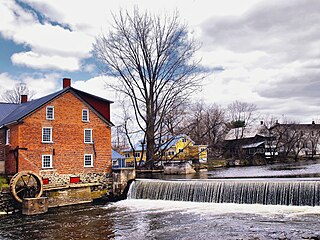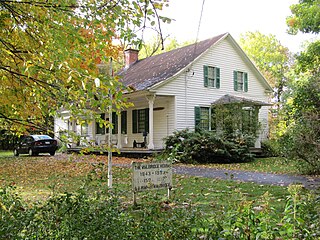Related Research Articles

The Estrie is an administrative region of Quebec that replaced the Eastern Townships. Estrie, a French neologism, was coined as a derivative of est, "east". Originally settled by anglophones, today it is about 90 per cent francophone. Anglophones are concentrated in Lennoxville, home of the region's only English-speaking university, Bishop's University. The Eastern Townships School Board runs 20 elementary schools, three high schools, and a learning centre.

Saguenay–Lac-Saint-Jean is a region in Quebec, Canada. It contains the Saguenay Fjord, the estuary of the Saguenay River, stretching through much of the region. It is also known as Sagamie in French, from the first part of "Saguenay" and the last part of "Piekouagami", the Innu name for Lac Saint-Jean, with the final "e" added to follow the model of other existing region names such as Mauricie, Témiscamie, Jamésie, and Matawinie. The name Saguenay is possibly derived from the Innu word "Saki-nip" which means "where water flows out". With a land area of 98,712.71 km2, the Saguenay–Lac-Saint-Jean is, after the Nord-du-Québec and Côte-Nord regions, the third-largest of Quebec regions in the area.
This article presents the current language demographics of the Canadian province of Quebec.

Bedford is a city located in the Montérégie region of southern Quebec, Canada. The population as of the Canada 2011 Census was 2,684. This small community is just an hour's drive from larger cities such as Burlington and Montreal.
The Demographics of Montreal concern population growth and structure for Montreal, Quebec, Canada. The information is analyzed by Statistics Canada and compiled every five years, with the most recent census having taken place in 2016.
Quebec English encompasses the English dialects of the predominantly French-speaking Canadian province of Quebec. There are few distinctive phonological features and very few restricted lexical features common among English-speaking Quebecers. The native English speakers in Quebec generally align to Standard Canadian English, one of the largest and most relatively homogeneous dialects in North America. This standard English accent is common in Montreal, where the vast majority of Quebec's native English speakers live. English-speaking Montrealers have, however, established ethnic groups that retain certain lexical features: Irish, Jewish, Italian, and Greek communities that all speak discernible varieties of English. Isolated fishing villages on the Basse-Côte-Nord of Quebec speak Newfoundland English, and many Gaspesian English-speakers use Maritime English. Francophone speakers of Quebec also have their own second-language English that incorporates French accent features, vocabulary, etc. Finally, the Kahnawake Mohawks of south shore Montreal and the Cree and Inuit of Northern Quebec speak English with their own distinctive accents, usage, and expressions from their indigenous languages.

Hemmingford is a township municipality in south-west Quebec, founded in 1799. The population as of the Canada 2011 Census was 1,747. The township completely surrounds the Village of Hemmingford. The two entities are locally referred to collectively as Hemmingford. The two share many things, such as the cost of the volunteer fire department, and both hold their councils and offices in the same building in the village.

For other places with the same name, see Havelock (disambiguation)

The Diocese of Montreal is a diocese of the Ecclesiastical Province of Canada of the Anglican Church of Canada, in turn a province of the Anglican Communion. The diocese comprises the 21,400 square kilometres (8,300 sq mi) encompassing the City and Island of Montreal, the Laurentians, the South Shore opposite Montreal, and part of the Eastern Townships. The See city is Montreal, and the cathedral is Christ Church. The diocese maintains approximately 9,000 on its parish rolls in about seventy parishes.

Côte-Nord-du-Golfe-du-Saint-Laurent is a municipality in the regional county municipality of Le Golfe-du-Saint-Laurent in the Côte-Nord region of the province of Quebec, Canada. The municipality consists of two non-contiguous areas, both along the shores of the Gulf of Saint Lawrence. The larger main part stretches from the Natashquan River to the Gros Mécatina River and includes all populated places. The eastern part is a small section between Middle Bay and Brador.

Dunham is a city in the Canadian province of Quebec, located in Brome-Missisquoi Regional County Municipality. The population as of the Canada 2011 Census was 3,471.

Stanbridge East is a municipality in the Canadian province of Quebec, located within the Brome-Missisquoi Regional County Municipality. The population as of the Canada 2011 Census was 873.

Saint-Ignace-de-Stanbridge is a municipality in the Canadian province of Quebec, located within the Brome-Missisquoi Regional County Municipality. The population as of the Canada 2011 Census was 638.
Lionel Albert is a businessperson, writer, and political activist in the Canadian province of Quebec. He is best known for his opposition to Quebec's language laws.
Heather Keith, formerly known as Heather Keith-Ryan, is an anglophone rights activist from the Eastern Townships region of the Canadian province of Quebec. She has served two terms as president of the Townshippers' Association and in this capacity has opposed provincial restrictions on the use of the English language. Keith herself is fluent in English and French.
The 2004 Quebec municipal referendums were held by the Quebec Liberal Party government of Jean Charest that came to power in the 2003 Quebec election, in fulfillment of a campaign promise to allow voters to have a say regarding the municipal reorganization program that had been undertaken by the preceding Parti Québécois administration.

The following outline is provided as an overview of and topical guide to Quebec:
École Maïmonide is a French-language Jewish day school in Montreal, Quebec. The school has two campuses: the Parkhaven Campus in Côte Saint-Luc and the Jacob Safra Campus in Saint-Laurent.
English-speaking Quebecers are a linguistic minority in the francophone province of Quebec. According to the 2011 Canadian census, 599,225 people in Quebec declare English as a mother tongue. When asked, 834,950 people reported using English the most at home.
Robert Dean was a Canadian politician and trade unionist. He was one of the few Anglophone Quebecers to join the Parti Québécois, which advocates for the independence of Quebec from Canada.